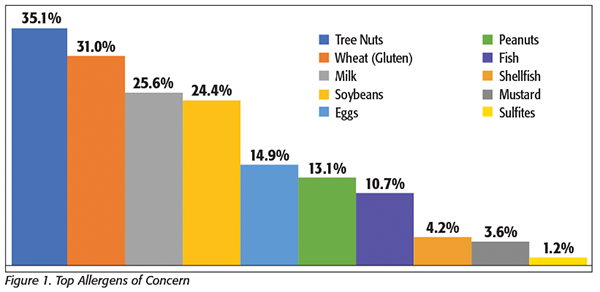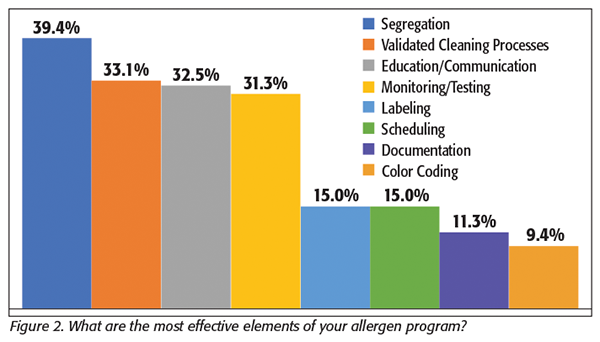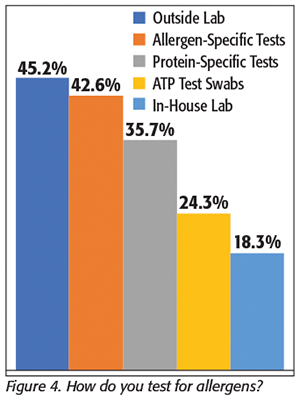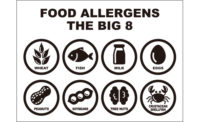In our work in the Food Safety Insights program, many trends have emerged in our surveys with processors, but few have been more pronounced than concerns over control of allergens and the related testing and sanitation practices used as a part of the processor’s control strategy.
To find out more, we surveyed approximately 275 food processors in 10 different food and beverage categories across 41 U.S. states and multiple provinces in Canada on their concerns about their allergen control and sanitation verification programs. We wanted to hear about their most pressing problems and how they are dealing with those key issues.
 We started by asking about their top allergens of concern and, to no surprise, the “Big Eight” allergens (milk, eggs, fish, shellfish, tree nuts, peanuts, wheat and soybeans) were the most listed (Figure 1), with approximately one out of three processors specifically listing tree nuts or gluten as their top concern and one in four listing milk or soy. Beyond these allergens, mustard and sulfites also made the list, as these are priority allergens in Canada. Canadian processors and U.S. processors with Canadian SKUs listed one or both as a concern for their program. Canada’s food and drug regulations list 11 priority allergens, including mustard, sulfites and sesame seeds (although sesame seeds were identified as an allergen of concern by only one respondent).
We started by asking about their top allergens of concern and, to no surprise, the “Big Eight” allergens (milk, eggs, fish, shellfish, tree nuts, peanuts, wheat and soybeans) were the most listed (Figure 1), with approximately one out of three processors specifically listing tree nuts or gluten as their top concern and one in four listing milk or soy. Beyond these allergens, mustard and sulfites also made the list, as these are priority allergens in Canada. Canadian processors and U.S. processors with Canadian SKUs listed one or both as a concern for their program. Canada’s food and drug regulations list 11 priority allergens, including mustard, sulfites and sesame seeds (although sesame seeds were identified as an allergen of concern by only one respondent).
We asked not just about top allergens but about all allergens and looked at the responses by processor type. The results showed that each processor type had their expected specific concerns (i.e., milk and eggs for dairy, nuts and peanuts for fruit and vegetables). Also, as expected, the data confirmed that prepared and processed foods companies, with the greatest numbers of recipes and use of different foods, had the broadest levels of concern, with more than one of two respondents listing milk, gluten, soybeans, eggs and tree nuts as key concerns and one in three listing peanuts, fish and shellfish.
Allergen Control
Allergens are an unavoidable part of food processing and effective control is key. For this reason, we also wanted to find out what processors felt were the most and least effective parts of their allergen control program. These questions were both posed—as we have done in the past—as open-response questions so as not to lead any respondents to any answer and so processors could “fill in the blank” and indicate any concern in any category.
 The most frequent allergen program strength, cited by close to 40 percent of respondents (Figure 2), was their processes for segregation and separation of the different food and ingredients they use. Close behind, all with approximately one-third of the respondents each indicating the element as a strength of their program, were validated cleaning processes, education and communication programs, and monitoring and testing programs.
The most frequent allergen program strength, cited by close to 40 percent of respondents (Figure 2), was their processes for segregation and separation of the different food and ingredients they use. Close behind, all with approximately one-third of the respondents each indicating the element as a strength of their program, were validated cleaning processes, education and communication programs, and monitoring and testing programs.
 When asked about the least effective elements (Figure 3) of their allergen program, respondents made it clear that their number one concern—cited by 37 percent of all respondents and more than double the response of the second-most-cited element—was employee training and compliance issues, followed by scheduling (17.5%) and undeclared allergens (16.3%), with comments showing the key issue with undeclared allergens being documentation of incoming raw materials.
When asked about the least effective elements (Figure 3) of their allergen program, respondents made it clear that their number one concern—cited by 37 percent of all respondents and more than double the response of the second-most-cited element—was employee training and compliance issues, followed by scheduling (17.5%) and undeclared allergens (16.3%), with comments showing the key issue with undeclared allergens being documentation of incoming raw materials.
Allergen Program Challenges
While processors are indicating that segregation and cleaning are a strength and employee issues are a weakness, it was also clear from the comments to our survey that both these key strengths as well as the key weaknesses of their allergen control programs were largely linked to employee issues. The processors, for example, clearly indicated that segregation processes were strengths of their allergen control programs, yet many mentioned that they needed more time and more people (which are really the same problem in most cases) to properly separate and store raw materials and finished products. Scheduling was second only to employee issues as the top weakness, but again, in their comments, the processors made it clear that the weaknesses were primarily attributable to human error and if “people would follow the SOPs [Standard Operating Procedures]” or “if we had more time and staff to conduct the scheduling and changeovers correctly,” there would be fewer errors.
These concerns with employee compliance with allergen control programs are very similar to what we have seen in the past related to sanitation issues. Therefore, as part of this project, we also asked survey respondents about sanitation practices, and two areas called out as difficult “sanitation” problems were employee lunchroom and break areas. Yet it was clear that no one really thought that employee lunchrooms were particularly difficult to clean (especially when compared with processing equipment) but indicated this was a compliance issue and the spaces would be relatively easy to manage if employees would not bring in allergen-containing foods that present the potential for cross-contamination of product in the first place. Similar comments were offered regarding equipment cleaning. While many respondents mentioned specific difficult cleaning challenges such as hard-to-reach areas and old equipment with less than modern sanitary design as weaknesses in their programs, these same professionals also mentioned that with less turnover and better employee compliance with procedures, plus sufficient time to get the work done, many (but not all) of these problem areas would disappear.
Allergen Program Strengths
The respondents nonetheless mentioned that validated cleaning processes and their related monitoring and testing processes were two strengths of their programs, so we wanted to find out more about how they accomplished this.
 Seventy-six percent of the respondents said they use rapid test kits (protein-specific, allergen-specific or ATP swabs) with allergen-specific tests being the most common (Figure 4); 30% of the respondents said they use multiple rapid test types. Only 44% of the respondents said that they exclusively use rapid tests, and while 45% said that they use an outside lab for at least some of their testing, only 19% reported using an outside lab exclusively.
Seventy-six percent of the respondents said they use rapid test kits (protein-specific, allergen-specific or ATP swabs) with allergen-specific tests being the most common (Figure 4); 30% of the respondents said they use multiple rapid test types. Only 44% of the respondents said that they exclusively use rapid tests, and while 45% said that they use an outside lab for at least some of their testing, only 19% reported using an outside lab exclusively.
Interestingly, we also received responses from 71 processors in 37 other countries; of those, 69% indicated that they use rapid test kits in their operations. Allergen-specific tests were the most common, with 30% using multiple types. These companies also reported that 59% use an outside lab (31% exclusively), and 41% exclusively use rapid methods. While we do not have a large enough sample size in any country or group of countries to project these results across the wider world market, these data are an indication of harmonization in this market and suggest that processors outside North America are using rapid tests and laboratories for allergen testing in similar proportions.
In our next column, we will continue to review the data from this project and reveal more about how these processors are managing a key component of their allergen program: cleaning and sanitation. Processors told us their key sanitation problems, how they are dealing with them and what they would like to see to help them do their job better. Stay tuned!
Bob Ferguson is the managing director of Strategic Consulting Inc. and can be reached at foodsafetyinsights@gmail.com or on Twitter at @SCI_Ferguson.
Testing and Sanitation for Allergen Control




